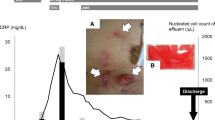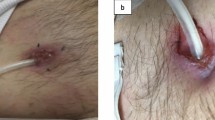Abstract
Purpose
Peritonitis can be a severe complication of peritoneal dialysis (PD) due to associated morbidity and mortality. Non-tuberculous mycobacteria (NTM) are a rare cause of PD peritonitis, with high rates of catheter removal and conversion to haemodialysis, and a reported mortality as high as 40 %. The incidence, culprit NTM species, and outcomes associated with PD peritonitis have not been described in many countries, including Australia.
Methods
We examined the Australia and New Zealand Dialysis and Transplant Registry from 1 October 2003 to 31 December 2009 for all prevalent peritoneal dialysis patients. Patient characteristics, organisms, treatment and outcome for all NTM PD peritonitis episodes were obtained.
Results
Twelve cases of NTM PD peritonitis were reported, including the first reports of infection due to Mycobacterium hassiacum and Mycobacterium neoaurum. The incidence of NTM PD peritonitis was approximately 1 per 1000 PD patient-years. Recovery occurred in 11 patients, including 3 without removal of their Tenckhoff catheters. A range of antibiotics were utilised. One patient died of sclerosing peritonitis 5 months after diagnosis of PD peritonitis.
Conclusion
Non-tuberculous mycobacteria PD peritonitis is a rare cause of peritonitis, and mortality may be lower than previously reported. Catheter removal occurred in the majority of patients, and adverse outcomes were not observed for those in whom it was retained.
Similar content being viewed by others
References
Brown F, Gulyani A, Dent H et al (2011) Chapter 6. Peritoneal dialysis. In: ANZDATA Registry 2011 Report: http://www.anzdata.org.au/v1/report_2011.html
Li PK, Szeto CC, Piraino B et al (2010) Peritoneal dialysis-related infections recommendations: 2010 update. Perit Dial Int 30(4):393–423
Brown-Elliott BA, Wallace RJ Jr (2002) Clinical and taxonomic status of pathogenic nonpigmented or late-pigmenting rapidly growing mycobacteria. Clin Microbiol Rev 15(4):716–746
Woo PC, Tsoi HW, Leung KW et al (2000) Identification of Mycobacterium neoaurum isolated from a neutropenic patient with catheter-related bacteremia by 16S rRNA sequencing. J Clin Microbiol 38(9):3515–3517
Morimoto Y, Chan ED, Heifets L et al (2007) Pulmonary infection with Mycobacterium neoaurum identified by 16S ribosomal DNA sequence. J Infect 54(4):e227–e231
Schroder KH, Naumann L, Kroppenstedt RM et al (1997) Mycobacterium hassiacum sp. nov., a new rapidly growing thermophilic mycobacterium. Int J Syst Bacteriol 47(1):86–91
Song Y, Wu J, Yan H et al (2012) Peritoneal dialysis-associated nontuberculous mycobacterium peritonitis: a systematic review of reported cases. Nephrol Dial Transplant 27(4):1639–1644
Jiang SH, Senanayake S, Talaulikar GS (2011) Peritoneal dialysis-related peritonitis due to Mycobacterium smegmatis. Perit Dial Int 31(2):215–216
LaRocco MT, Mortensen JE, Robinson A (1986) Mycobacterium fortuitum peritonitis in a patient undergoing chronic peritoneal dialysis. Diagn Microbiol Infect Dis 4(2):161–164
Renaud CJ, Subramanian S, Tambyah PA et al (2011) The clinical course of rapidly growing nontuberculous mycobacterial peritoneal dialysis infections in Asians: a case series and literature review. Nephrology (Carlton) 16(2):174–179
Pulliam JP, Vernon DD, Alexander SR et al (1983) Nontuberculous mycobacterial peritonitis associated with continuous ambulatory peritoneal dialysis. Am J Kidney Dis 2(6):610–614
Jiang SH, Roberts DM, Dawson AH, Jardine M (2012) Mycobacterium fortuitum as a cause of peritoneal dialysis-associated peritonitis: case report and review of the literature. BMC Nephrol 13:35. doi:10.1186/1471-2369-13-35
Fahim M, Hawley CM, McDonald SP et al (2010) Culture-negative peritonitis in peritoneal dialysis patients in Australia: predictors, treatment, and outcomes in 435 cases. Am J Kidney Dis 55(4):690–697
The CARI guidelines—Treatment of peritoneal dialysis-associated peritonitis in adults (2004). http://www.cari.org.au/guidelines.php
Falkinham JO 3rd (1996) Epidemiology of infection by nontuberculous mycobacteria. Clin Microbiol Rev 9(2):177–215
Griffith DE, Aksamit T, Brown-Elliott BA et al (2007) An official ATS/IDSA statement: diagnosis, treatment, and prevention of nontuberculous mycobacterial diseases. Am J Respir Crit Care Med 175(4):367–416
Rigby RJ, Hawley CM (1998) Sclerosing peritonitis: the experience in Australia. Nephrol Dial Transplant 13(1):154–159
Acknowledgments
Medical and nursing staff from Australian Renal units for their contributions to the database.
Conflict of interest
The authors declare that they have not conflicts of interest.
Author information
Authors and Affiliations
Corresponding author
Rights and permissions
About this article
Cite this article
Jiang, S.H., Roberts, D.M., Clayton, P.A. et al. Non-tuberculous mycobacterial PD peritonitis in Australia. Int Urol Nephrol 45, 1423–1428 (2013). https://doi.org/10.1007/s11255-012-0328-4
Received:
Accepted:
Published:
Issue Date:
DOI: https://doi.org/10.1007/s11255-012-0328-4




